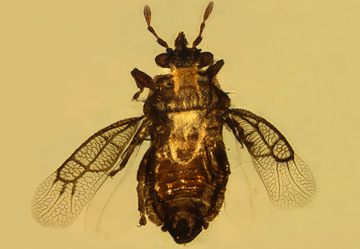Abstract
Scolebythidae is a small relict family of ordinary looking small wasps with only four genera and six species in the contemporary fauna of Central and South America, South Africa, Madagascar, north China, Thailand, Australia and Fiji; and with 11 genera and 13 species in various Cretaceous, Eocene and Miocene ambers and rocks (Engel, 2015; present paper) ascribed to two subfamilies, one predominantly living and another mostly extinct (Engel et al., 2013). Biologically, Scolebythidae are known as gregarious parasites of xylophagous larvae of Cerambycidae and Ptinidae (Anobiinae) (summarized by Engel, 2015). Based on the morphology, the family is usually considered phylogenetically as the second most (after Plumariidae) basal one in Chrysidoidea (Brothers, 1975; Rasnitsyn, 1988, 2002; Brothers & Carpenter, 1993).
References
Brothers, D.J. (1975) Phy1ogeny and classification of the aculeate Hymenoptera, with specia1 reference to Mutillidae. University оf Kansas Science Bulletin, 50, 483–648.
Brothers, D.J. & Carpenter, J.M. (1993) Phylogeny of Aculeata: Chrysidoidea and Vespoidea (Hymenoptera). Journal of Hymenoptera Research, 2, 227–304.
Cockx, P.F.D. & McKellar, R.C. (2016) First record of the family Scolebythidae (Hymenoptera) in mid-Cretaceous amber from Myanmar. Cretaceous Research, 67, 133–139.
https://doi.org/10.1016/j.cretres.2016.06.015
Engel, M.S. (2015) The wasp genus Clystopsenella in Early Miocene amber from the Dominican Republic (Hymenoptera: Scolebythidae). Novitates Paleoentomologicae, 12, 1–14.
https://doi.org/10.17161/np.v0i12.4958
Engel, M.S., Ortega-Blanco, J. & McKellar, R.C. (2013) New scolebythid wasps in Cretaceous amber from Spain and Canada, with implications for the phylogeny of the family (Hymenoptera: Scolebythidae). Cretaceous Research, 46, 31–42.
https://doi.org/10.1016/j.cretres.2013.09.003
Li, L.F., Rasnitsyn, A.P., Shih, C.K., Li, D.Q. & Ren, D. (2018) A new wasp of Myanmarinidae (Hymenoptera: Stephanidae) from the mid-Cretaceous Myanmar amber. Cretaceous Research, 86, 33–40.
https://doi.org/10.1016/j.cretres.2018.02.009
Martynova, K.V., Olmi, M., Müller, P. & Perkovsky, E.E. (2019) Description of the first sclerogibbid wasp (Hymenoptera: Sclerogibbidae) from Burmese (Myanmar) amber and its phylogenetic significance. Journal of Systematic Palaeontology, 17 (21), 1791–1803.
https://doi.org/10.1080/14772019.2018.1551250
Melo, G.A.R., & Lucena, D.A.A. (2019) †Chrysobythidae, a new family of chrysidoid wasps from Cretaceous Burmese amber (Hymenoptera, Aculeata). Historical Biology, doi: 10.1080/08912963.2019.1570184.
https://doi.org/10.1080/08912963.2019.1570184
Rasnitsyn, A.P. (1969) Origin and evolution of the lower Hymenoptera. Transaction of the Paleontological Institute, Academy of Sciences of the USSR, 123, 1–196 [In Russian; English translation in 1979 by Amerind Publ. Co., New Delhi].
Rasnitsyn, A.P. (1975) Hymenoptera Apocrita of the Mesozoic. Trudy Paleontologicheskogo Instituta Akademii Nauk SSSR, 147, 1–134 [In Russian].
Rasnitsyn, А.Р. (1988) An outline of the evolution of the hymenopterous insects (Order Vespida). Oriental Insects, 22, 115–145.
https://doi.org/10.1080/00305316.1988.11835485
Rasnitsyn, A.P. (2002) 2.2.1.3.5. Superorder Vespidea Laicharting, 1781. Order Hymenoptera Linné, 1758 (= Vespida Laicharting, 1781). In: Rasnitsyn, A.P. & Quicke, D.L.J. (Eds). History of insects. Kluwer Academic Publishers, Dordrecht, The Netherlands. 242–254 pp.
Shi, G., Grimaldi, D.A., Harlow, G.E., Wang, J., Wang, J., Yang, M., Lei, W., Li, Q. & Li, X. (2012) Age constraint on Burmese amber based on U-Pb dating of zircons. Cretaceous Research, 37, 155–163.
https://doi.org/10.1016/j.cretres.2012.03.014
Smith, R.D.A. & Ross, A.J. (2018) Amberground pholadid bivalve borings and inclusions in Burmese amber: implications for proximity of resin producing forests to brackish waters, and the age of the amber. Earth and Environmental Science Transactions of the Royal Society of Edinburgh, 107, 239–247.
https://doi.org/10.1017/S1755691017000287
Zhang, Q., Rasnitsyn, A.P., Wang, B. & Zhang, H.C. (2018) Hymenoptera (wasps, bees and ants) in mid-Cretaceous Burmese amber: a review of the fauna. Proceedings of the Geologists Association, 129 (6), 736–747.

